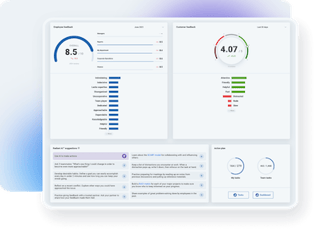
WFH is Here to Stay: Best Practices for a Remote Workforce
The COVID-19 global pandemic brought unprecedented challenges to the 2020 workforce. Based on guidelines from the WHO and Centers for Disease Control and Prevention (CDC) in the United States, many businesses had to undergo a sudden, rapid transition to remote work in an effort to keep employees safe and operations steady.
While remote work has been on the rise for years, many businesses did not have formal policies in place for remote work or the infrastructure to support a large volume of employees working 100% remotely before 2020. Today, many businesses have decided to continue work-from-home operations through early 2021. Based on feedback collected from our partners over the past 4 months, we've compiled a list of best practices for building a functional long-term remote infrastructure, keeping communication alive, and addressing the most common issues encountered by remote workers.
Building a remote infrastructure
Employees must have access to the tools and resources needed to do their jobs well. This is true for any work environment. The success of your transition to remote work depends on the infrastructure, both physical and virtual, supporting your remote employees.
Physical
At minimum, most businesses will need to provide laptop computers to each remote employee. But, in order for employees to be just as productive at home as they are at work, their home office must be as supportive to their work as their work office. If you have a dual monitor setup in the office, but just a laptop at home, you’ll probably have a harder time managing your everyday tasks. If you make a lot of calls in the office on your headset, you might struggle to find the same rhythm at home with your smartphone and earpods.
Carve Out Your Command Central
When working remotely, especially within your home on a laptop, your office can be fluid. You can be at the kitchen table one minute, then out on the patio, then over on the couch, and anywhere else available to you. For some people, the freedom to move around keeps them energized and productive. For others, it can represent an uphill battle to find peace and quiet. Children, pets, roommates, and partners can be distracting, and getting work done can become a struggle when you’re bouncing from room to room to avoid distractions.
Look around your living space, and carve out your own office, ideally someplace quiet and private. Keep all your work materials there, and make it clear to those around you that when you are in your “office,” you are not to be disturbed. The beauty of this system is: you can still be mobile! If you’re working on tasks that you can accomplish outside while sipping a cup of coffee or on the couch while your kids play video games, then you can enjoy the flexibility of working remotely- on your own terms.
Make Your Wishlist
If you are missing resources that would help you be more productive working at home, make them known to your manager and to HR. Write out a reasonable “wishlist” for your home office that includes all physical equipment you relied on in-office. This list may include: dual monitors, headsets, ethernet cables, or other computer equipment, but can also include ergonomic resources like a special keyboard and mouse or a height-adjustable desk attachment. If it was important for you to have these tools in the office, it’s just as important for you to have them when working at home.
“Easier Said Than Done!”
Managers, we know: your company might not have the resources right now to invest in new materials for remote employees. Or, supply chain disruptions might present challenges in getting these resources to employees. In these cases, consider creating a system that allows employees to “check out” their computer and office equipment. Set up a designated date and time for employees to come into the office to get what they need and record the resources they relocate to their home offices. When employees resume working in-office, you can set up times to review everyone’s workspace to ensure that all equipment has been returned. This might seem like a big use of your time, but every minute spent investing in employees’ productivity will pay dividends down the road. The hardware you’ve purchased won’t make an empty office more productive. It’s better off with the employees who need it.
Virtual
Just as we rely on physical resources like keyboards and monitors to get work done, many employees depend on virtual resources to be productive, particularly when working remotely. Many employees who work with proprietary or otherwise confidential information can only access this information through their company’s internal network. Office computers are physically connected to the company’s internal network, so employees can access all the information they need with no issues. But, when working remotely, employees do not have physical access to their company’s network. In these cases, the company should set up a VPN (virtual private network) server. This allows employees to access the company’s network remotely, once their laptops or workstations are equipped with the necessary VPN client, which is a software program that establishes a connection to the VPN server.
For many companies, enabling VPN access is the single most important step in the transition to remote work. Managers should work with IT personnel to ensure that every remote employee has a strong, steady VPN connection. IT should also ensure that the company’s VPN server can support the sudden influx of remote connections. For employees who depend on it, their VPN connection going down is the virtual equivalent of being locked out of the office.

Communication
Communication is a common struggle in the workplace, and it can become even more of a challenge when working remotely. If employees do not have the tools necessary to communicate effectively from their home offices, productivity will decline and conflict will be inevitable. Most remote employees have regular access to email and some form of IM or chat, but text-based communication often lacks critical context
Tone cannot be communicated over email or IM. When the recipient of a terse or confusing message tries to interpret the sender’s tone, it often results in unnecessary conflict that divides the team and hurts morale. Whereas, 96% of respondents agree or strongly agree that video conferencing is effective for improving the connectedness of remote team members.
Lead by Example
Although the data shows communication tools help bring remote teams together, managers can still expect some resistance to these changes in communication. Employees new to remote work might feel uncomfortable showing their faces on video conferences, Millennials famously despise talking on the phone (Forbes), etc.
Managers should take proactive steps to ease their teams’ discomfort with video and voice conferencing tools by being active and consistent with these tools. Always have your webcam on in team meetings, and set the expectation that others do the same. If you have a complicated question or sensitive issue, ask your employee for a quick call to talk it over. By setting this example, you’re encouraging better communication and stronger connections within your team.
Dial it Up
If your team is newly remote and looking at an indefinitely remote future, your regular meeting schedule might not be sufficient to keep up with the issues your employees are facing. Few people like the thought of adding more recurring meetings to the schedule, yet 86% of executives, managers, and employees blame ineffective communication for their workplace failures. Keeping communication active and effective through the transition to remote work is absolutely essential. Daily standups, lightning fast meetings where everyone on the team gives an update on what they’re working on and what issues they’re facing, are a great way to keep the team connected without wasting anyone’s time.
If you don’t have one already, establish a regular 1:1 meeting with each of your direct reports. Let your employee run the meeting and encourage them to use it as their time to share updates, ask questions, or plan for the future. When your schedule gets overloaded, you might be tempted to fall back on email updates from the team, but try to use this only as a last resort.
Common issues and best practices
Loneliness and isolation
One-fifth of remote workers cite “loneliness” as their biggest struggle with working remotely (Gallup). While one in five is already a significant number, it’s also important to note that this figure comes from surveying an established remote workforce, i.e. people who elected to work remotely. In this recent transition to remote work due to the public health crisis, many employees who were used to being in-office 100% are now working remotely 100% with no transition period. These employees who didn’t necessarily “sign up” for remote work might be at even greater risk of experiencing feelings of loneliness and isolation, especially when compounded by increasing restrictions on social gatherings.
While research does indicate that most employees will thrive in a remote work environment, no one is immune to occasional feelings of loneliness. If you’re used to having frequent meetings with the team, lunch with your work buddies, casual chats in the breakroom, and impromptu 1:1’s in your manager’s office, this indefinite transition to remote work might leave you feeling isolated. This perceived isolation can lead to as much as a 21% drop in performance (Gallup).
Managers, Step Up
We often focus on the negative implications with manager-employee dynamics (citing the old adage, “people leave managers, not companies”), but managers account for at least 70% of the variance in employee engagement levels, which means a great manager can make all the difference when an employee is struggling. Managers should be responsible for creating an infrastructure for communication that leaves their team feeling connected. Any standing meeting that happened in-office should be replaced with a remote equivalent. Manager-employee 1:1’s should occur at least as frequently as they did in-office. If you did not have a formal pattern for checking in with your employees, establish one now. Create space for your employees to share their experiences with working from home.
Virtualize your connections
You can still socialize at work when working from home. It might not feel as natural to socialize over chat or video conferencing, but making the effort to maintain your social connections as your time working from home extends will be a huge help in warding off feelings of loneliness and isolation. Set up a standing 15-min meeting to connect with your best friend at work via Skype or FaceTime. Keep your lunch dates with friends on your calendar and chat over text while dining at home. It might feel silly at first, but those little breaks and social connections will make you happier and more productive through the transition to remote work.

Disconnected teammates
When a team becomes remote, frustrations may arise from having less immediate and direct access to your teammates. In an office environment, you can physically “pop in” to a teammate’s work area to get a quick response to your question or request if you haven’t gotten a reply to your email or chat. When working remote, you don’t have this option, which can cause friction if your work is being held up while you wait for a response.
In today’s workforce, everyone is always busy. Many employees wear multiple hats and work on different projects at the same time. In these cases, work has to be prioritized. But, prioritization isn’t the cause of this friction; rather, it’s the lack of communication and visibility into others’ priorities that creates frustration within remote teams. If you get an email about project A but your work on project B is more time-sensitive, a simple reply of: “working on project B - I’ll have time to address this tomorrow,” lets your teammate know that you’ve seen their request and have a plan for getting back to them vs. leaving them to wait on a response.
Corporate Culture Change: Email Etiquette
Every remote employee should understand the importance of being responsive to emails and chat, and your company culture and attitude toward virtual communication might need to evolve to support this. Many employees feel that emails should be reserved for formal communication and progress updates, so it may not feel natural for them to reply with a: “can’t get to this now, check back in the AM.” But these quick notes keep others informed and help them plan out their own schedules. If you need an answer to your question in order to continue with a task, knowing that the answer won’t come until tomorrow means you can focus on other tasks until then.
Try it Out: Triage
Prioritization is always a challenge, and remote work can exacerbate this because you don’t receive the same level of context around each task that you would in a physical setting. When you couple this with decreased access to your colleagues, it can lead to issues where some feel their tasks aren’t getting enough attention and others feel unsure if they’re working on the right tasks at the right times. One way to address this is to implement a triage system within your existing communication platforms. For example:
Level 1: Instant message - reserved for questions or requests that aren’t time sensitive. If a response isn’t received, either ask someone else or escalate to level 2.
Level 2: Email - questions or requests that do not need to be answered in the next 24 hours. If a response is not received and the issue becomes time-sensitive, escalate to level 3 in a new email.
Level 3: Email with subject line “Urgent” - questions or requests that need to be answered within 24 hours. This helps employees know which emails need an immediate response.
Increased stress and productivity pressure
The pressure to be productive- and appear productive- is intense in today’s workforce. 15% of employees surveyed by Colonial Life said increasing pressure at work has pushed them into looking for other jobs, and over a third of employees are at risk of burning out within a year. Today, employees who were already under immense stress at work are now facing additional external stress related to childcare, elderly parents, and their own health and safety.

Listen to Employees
Employees who feel stressed, isolated at work, and disconnected from their teammates are highly unlikely to bring their best work to the table. If businesses want to help their employees with their work-from-home struggles, they first need to understand what they are and how they're impacting employees' well-being. Surveys are an excellent tool for collecting this feedback in a structured format that encourages employees to share their honest feelings and experiences.
-
For most employees who transitioned to work-from-home in 2020, the move was anything but smooth. Many continue to face challenges from ongoing external stresses, increased pressure at work, feeling disconnected from our coworkers, and just feeling lonelier in general. As we cross into the second half of 2020, many businesses have decided to continue their work-from-home operations, which means these issues will persist. But human beings are relentlessly adaptive, and we've found these strategies to be an immense help to managers and employees alike as we continue to learn from and support each other in this new normal.





